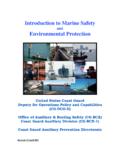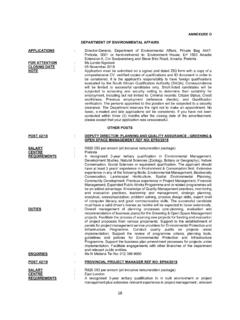Transcription of TATE OIL AND NATURAL GAS REGULATIONS - gwpc.org
1 department of Energy office of Fossil EnergyNational Energy Technology LaboratorySTAT E OIL AND NATURAL GAS REGULATIONSDESIGNED TO PROTECT WATER RESOURCESMay 2009 1 This page intentionally left blank 2 DISCLAIMERS 1. This report was prepared as an account of work sponsored by an agency of the United States Government. Neither the United States Government nor any agency thereof, nor any of their employees, makes any warranty, express or implied, or assumes any legal liability or responsibility for the accuracy, completeness, or usefulness of any information, apparatus, product, or process disclosed, or represents that its use would not infringe privately owned rights. Reference herein to any specific commercial product, process, or service by trade name, trademark, manufacturer, or otherwise does not necessarily constitute or imply its endorsement, recommendation, or favoring by the United States Government or any agency thereof.
2 The view and opinions expressed herein do not necessarily state or reflect those of the United States Government or any agency thereof 2. The electronic version of this report contains hyperlinks to documents, reports, presentations, websites and other reference materials. The Ground Water Protection Council (GWPC) does not warrant the viability of any hyperlinked reference in the report. The text of the Addendum does not represent the full or official published version of a state s rules or REGULATIONS and is provided for reference purposes only. The Addendum is current through August 1, 2008. ACKNOWLEDGMENTS This project was funded by the department of Energy (DOE), office of Fossil Energy, Oil and NATURAL Gas Program, and prepared for the DOE, National Energy Technology Laboratory (NETL) through a cooperative agreement (DOE Award No. DE-FC26-04NT15455). Ms. Sandy McSurdy, NETL Project Manager, provided oversight and report development guidance.
3 The Ground Water Protection Council (GWPC) conducted this study. We thank and acknowledge contributions and assistance from the following: John Veil, Argonne National Laboratory, Scott Anderson, Environmental Defense Fund, Thomas Richmond, Montana Board of Oil and Gas, Lori Wrotenbery, Oklahoma Corporation Commission, Wilma Subra, Subra Company, Inc., Alabama State Oil & Gas Board, Illinois department of NATURAL Resources, Division of Oil and Gas, Indiana department of NATURAL Resources, Division of Oil and Gas, Kansas Corporation Commission, Louisiana office of Conservation, Michigan department of Environmental Quality, Oil and Gas, Montana Board of Oil and Gas, New Mexico Oil Conservation Division, New York department of Environmental Conservation, Division of Mineral Resources, North Dakota Industrial Commission, West Virginia department of Environmental Protection, office of Oil and Gas, Wyoming Oil and Gas Conservation Commission, Oil and Gas Accountability Project, Schlumberger Well Services, Inc.
4 , State Review of Oil and NATURAL Gas Environmental Regulation, Inc. (STRONGER), and Interstate Oil and Gas Compact Commission (IOGCC). 3 Forward The purpose of oil and NATURAL gas REGULATIONS is to establish the framework within which regulatory programs insure that protection of the environment, especially water, is given the highest consideration with respect to the development of oil and gas resources. While REGULATIONS are not the sole measure of regulatory effectiveness, they are an indicator of regulatory intent. They form the backbone of the regulatory program. Without REGULATIONS there would be little if any control over processes with the potential to create environmental harm. Programmatic elements implemented in conjunction with regulatory language form the basis for an effective regulatory program. The reader should keep this in mind and consult each state regulatory agency website or speak with appropriate state agency staff, before concluding that a particular area is not addressed by a particular state.
5 For example, New York's department of Environmental Conservation (DEC) relies on statutory authority and regulation, but also utilizes an environmental review process, technical guidelines and special permit conditions to ensure safe and environmentally protective development of oil and gas resources. New York's broad statutory powers are conveyed in Article 23 of the Environmental Conservation Law. Rules and REGULATIONS contained in 6 NYCRR Parts 550-559 establish permitting practices and safeguards such as well setbacks from structures, roads, surface water bodies and streams. However, the DEC's Division of Mineral Resources also reviews all oil and gas drilling permits in accordance with the State Environmental Quality Review Act (SEQRA) to ensure that the environmental impact of resource extraction will be mitigated to the greatest extent possible. Further, a Generic Environmental Impact Statement (GEIS) completed in 1992 evaluates potential environmental impacts from oil and gas drilling and recommends mitigation practices.
6 Regulatory elements such as these are designed to insure oil and gas operations are conducted in a manner that is both safe and environmentally protective. The report you are about to read is designed to convey the intent of REGULATIONS enacted by states for the purpose of protecting water resources. Although the content of the report does not reflect the unanimous views of all members of the Ground Water Protection Council, it is offered as a general view of the GWPC member states. Mike Paque GWPC Executive Director 4 Table of Contents EXECUTIVE SUMMARY .. 6 1. Introduction .. 8 2. Selection of Study States .. 9 3. Background and Scope .. 10 4. History of Oil and Gas Regulation .. 12 A. Prior to 1935; The Early Years .. 13 B. 1935; Oil and Gas Conservation Is Born .. 13 C. 1945 to 1970: The Years of Oil Production Dominance .. 14 D. The Environmental 1970s and 1980s .. 14 5. The Role of Current State Oil and Gas Regulation in Water Protection.
7 17 A. Permitting .. 17 B. Well Construction .. 18 1) Well Materials and Construction Requirements .. 18 2) The Casing and Cementing Process .. 19 3) The Relationship of Well Construction to Ground Water Protection .. 21 C. Hydraulic Fracturing .. 21 1) The Process of Formation Stimulation Using Hydraulic Fracturing .. 21 2) Fracture Fluids, Exposure Pathways and Isolation Techniques .. 22 a. Fracture Fluids .. 22 b. Exposure Pathways .. 23 c. Isolation Techniques .. 23 3) Well Treatment Reporting .. 25 D. Temporary Abandonment of Wells .. 25 E. Well Plugging .. 26 1) Plugging Materials .. 26 2) Plugging Intervals and Methods .. 27 3) Plugging Reporting .. 27 F. 28 G. Pits .. 29 H. Waste Handling and Spills .. 30 6. The RCRA Exemption and State Review .. 32 A. History of the RCRA Exemption .. 32 B. The State Review Process .. 33 C. The State Review Process Becomes STRONGER .. 33 D. State Review Accomplishments.
8 34 7. Data Management .. 35 58. Key Messages and Suggested 37 About the Authors .. 42 List of Acronyms and Terms .. 43 References .. 44 Attachments .. 46 Attachment 1: Survey of State CBM Hydraulic Fracturing Practices, GWPC 2008 Attachment 2: Oil and Gas Production by State for 2006 Attachment 3: List of Crosswalk Review Areas of State Oil and Gas REGULATIONS Related to Water Protection Attachment 4: Text of the Memorandum of Agreement Between the United States Environmental Protection Agency and BJ Services Company, Halliburton Energy Services, Inc., and Schlumberger Technology Corporation Elimination of Diesel Fuel in Hydraulic Fracturing Fluids Injected into Underground Sources of Drinking Water During Hydraulic Fracturing of Coalbed Methane Wells Attachment 5: Example Cement Bond Log/ Variable Density Log Showing Good Cement Bond Attachment 6: Example Cement Bond Log/ Variable Density Log Showing No Cement Bond/ Free Pipe Attachment 7: Memorandum of Agreement between the Indiana department of NATURAL Resources, Division of Oil and Gas and the Indiana department of Environmental Management Addendum: State Oil and Gas REGULATIONS Reference Document (Go to ) 6 EXECUTIVE SUMMARY Over the past several years the GWPC has been asked, Do state oil and gas REGULATIONS protect water?
9 How do their rules apply? Are they adequate? The first step in answering these questions is to evaluate the regulatory frameworks within which programs operate. That is the purpose of this report. State regulation of oil and NATURAL gas exploration and production activities are approved under state laws that typically include a prohibition against causing harm to the environment. This premise is at the heart of the regulatory process. The regulation of oil and gas field activities is managed best at the state level where regional and local conditions are understood and where REGULATIONS can be tailored to fit the needs of the local environment. Hence, the experience, knowledge and information necessary to regulate effectively most commonly rests with state regulatory agencies. Many state agencies use programmatic tools and documents to apply state laws including REGULATIONS , formal and informal guidance, field rules, and Best Management Practices (BMPs).
10 They are also equipped to conduct field inspections, enforcement/oversight, and witnessing of specific operations like well construction, testing and plugging. REGULATIONS alone cannot convey the full measure of a regulatory program. To gain a more complete understanding of how regulatory programs actually function, one has to evaluate the use of state guides, manuals, environmental policy processes, environmental impact statements, requirements established by permit and many other practices. However, that is not the purpose of this study. This study evaluates the language of state oil and gas REGULATIONS as they relate to the direct protection of water resources. It is not an evaluation of state programs. To conduct the study, state oil and gas REGULATIONS were reviewed in the following areas: 1) permitting, 2) well construction, 3) hydraulic fracturing, 4) temporary abandonment, 5) well plugging, 6) tanks, 7) pits, and 8) waste handling and spills.














